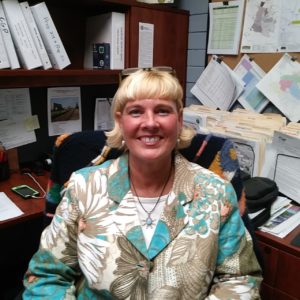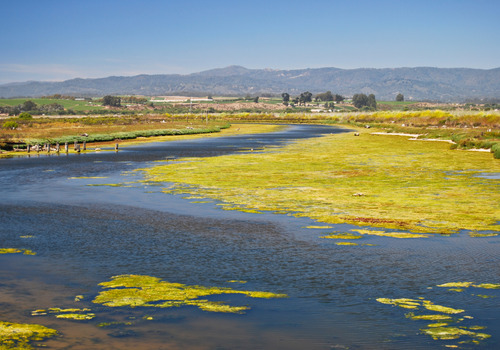As NPDES Program Manager for Salinas, CA, Heidi Niggemeyer indicated that the City’s annual MS4 report regularly took over 1,000 hours and around three to four months to complete. The effort involved several city staff members and over 1000 staff hours. In 2017, Heidi submitted an annual report containing over 2,500 pages. “It was a huge effort,” Heidi says. “Many, many, many hours, that resulted in a big pdf document that we’d chunk over to the regional water board every year.”
“I needed a tool that would centralize and organize our stormwater program data collection, and help us plan for the future.”
— Heidi Niggemeyer, NPDES Program Manager, Salinas
The Challenges of Producing an MS4 Annual Report

The City’s annual report took so much effort to produce due to many compounding factors. Teams from across Salinas generated various pieces of required information and data that were often stored in different systems, ranging from file cabinets to spreadsheets to custom databases. With limited access to these systems, Heidi initially had no way to know if data was being obtained and compiled correctly. She often had trouble even locating the required data.
Worst of all, these pages and pages of numbers, inspection forms, and narrative summaries didn’t tell Heidi, or her state regulators, whether the receiving waters in Salinas were getting any cleaner. Those 2,500 pages provided evidence that the required sampling, inspections, and programmatic actions had taken place, but she had no easy way to aggregate and analyze the data to make the connection between effort and results. Heidi needed more than just data to comply with the requirements in her permit or make program management decisions.
Heidi used data to turn her 2,500 page MS4 annual report into 30 pages her regulator loves
Read the profileSalinas’ water quality monitoring program spent hundreds of thousands of dollars each year testing grab samples taken from the regulated receiving waters that run through the city. Still, all those lab results didn’t tell Heidi how effective the City’s efforts were at improving Salinas’ stormwater quality, what the City’s actual contribution to the water quality impairment was, or where she should focus future resources to make actual progress to improve water quality. She was paying for a lot of data, but getting very little insight in return.
A Difficult Relationship With the Water Board
In addition, Heidi inherited a difficult relationship with the Central Coast Water Board, given that past audits had found shortcomings in compliance with their MS4 stormwater permit. Heidi was hired to turn the situation around, and she was determined to do so. She hoped that building open communication with the regulators might help her better understand some of the vague language in the City’s MS4 permit and ensure she could find practical pathways to compliance. She started asking questions, and soon she and the regulators were having productive conversations that clarified concrete measures she could take to bring Salinas into compliance with their challenging permit. Through a collaborative effort with the regional board, a new permit was adopted in 2019 that made more sense. Data was no longer being collected for data’s sake.
“Now we have a way of geospatially seeing the results of our inspections immediately,” Heidi says. “All of our stormwater information is kept in one centralized location. It’s much better.”
— Heidi Niggemeyer, NPDES Program Manager, Salinas
One requirement of the new permit was having a Stormwater Information Management System (SIMS). With limited resources and staff, Heidi realized she needed a technological solution that would give her the data and program visibility she needed. “I needed a tool that would centralize and organize our stormwater program data,” Heidi says. “And help us plan for the future.” She imagined a system that would let her transform the data the City had spent so much time and money collecting into a geospatially-based program that would help her literally see how effective the City’s stormwater program was and make strategic decisions moving forward based on what was and wasn’t working. She needed a digital transformation: a whole new way of managing the City’s stormwater program.
Solving Stormwater Management Problems with 2NFORM
Heidi researched options for software to get the stormwater program organized, and she found 2NFORM. 2NFORM is a robust software platform that brings structured data intelligence to MS4 compliance and stormwater management. Foundational modules handle information management and reporting that help move operations towards compliance with MS4 permits. Additional modules empower stormwater managers with advanced analytics and planning capabilities, using existing data to drive actual improvements in water quality. It was exactly what she needed.
Easier Inspections and Assessments
With 2NFORM, Heidi is optimizing her efforts. She now uses interns to perform field inspections and assessments, freeing up higher level staff time. The Maintenance Department also loves utilizing the field apps. Easy to use mobile forms guide field inspectors to collect exactly the right data in a standardized format that is represented on geospatial maps, which Heidi can view on the 2NFORM platform. “Now we have a way of geospatially seeing the results of our inspections immediately,” Heidi says. “All of our stormwater information is kept in one centralized location. It’s much better.”
The entire stormwater team can see the history and status of key stormwater program elements, such as stormwater structural BMP inspections, catch basin maintenance, locations of low impact development projects, construction projects, and more. Heidi can view and filter all of the city’s data in easy to understand maps, forms and tables at any time, anywhere. The City’s stormwater program is much more organized now, and every step is more efficient.
Quantifiable, Measurable, Verifiable
Better yet, everything is quantified and measurable, so comparing program results from year-to-year is easy. 2NFORM generates useful charts and tables to show progress. Built-in analytics, based on the most current, peer-reviewed stormwater science, let Heidi understand how the program is working, and guide her to the actions and tools that work best for her community. Compliance used to feel like just checking boxes. Now, the requirements in the Salinas MS4 permit have become a path to achieving cleaner stormwater.
A Shorter, Easier MS4 Annual Report
As for that annual report, both Heidi and her regulators are pleased that it is no longer such a sprawling document. It takes days, not months, for Heidi and team to compile. 2NFORM translates Salinas’ data into a comprehensive report complete with analytics with the click of a button. “It’s a lot easier,” Heidi says. “The data is already in the system, and 2NFORM summarizes our information all throughout the year. Regulators can view the City’s progress as well. Now our annual report is only about 30 pages long. Our regulators like it, too.”


